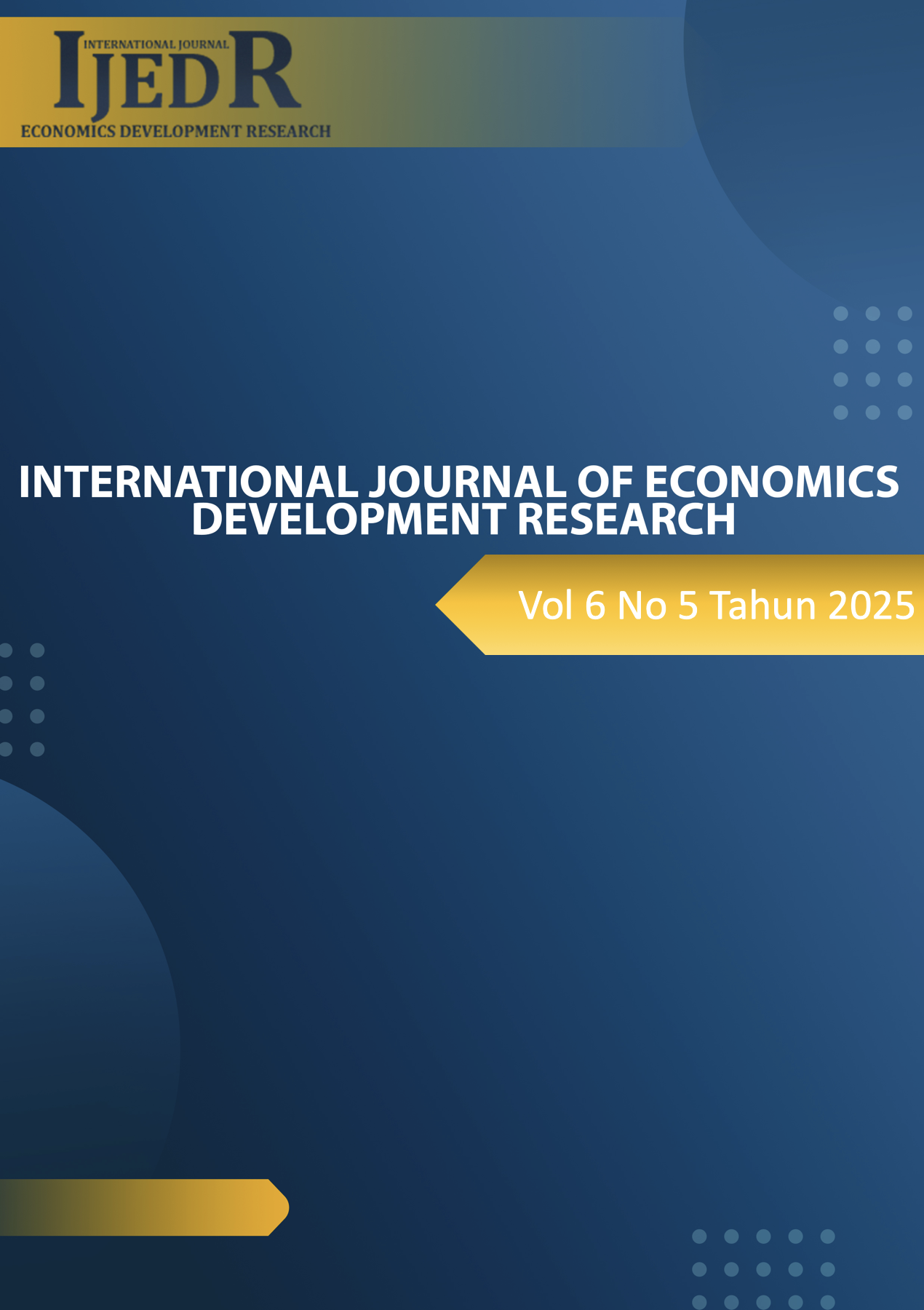Inclusive Regional Development: Implementation of the Child-Friendly Regency Policy in Bogor Regency
DOI:
https://doi.org/10.37385/ijedr.v6i5.8392Keywords:
Child-Friendly Regency/City, Basic Health and Welfare, Policy Implementation, Inclusive Regional Development, Bogor RegencyAbstract
This study explores the implementation of the Child-Friendly Regency/City (KLA) policy in Bogor Regency, specifically focusing on Cluster III: Basic Health and Welfare, as part of efforts to promote inclusive regional development. The research is motivated by the high infant mortality rate in Bogor Regency—the highest in West Java with 799 reported cases—and the region’s current "developing" status in the national KLA assessment. Employing a qualitative descriptive approach, data were collected through interviews, document analysis, and field observations. The findings reveal four key obstacles hindering effective policy implementation: (1) the absence of local regulations governing child-friendly childbirth services and health facilities; (2) limited infrastructure and transportation access to healthcare for remote communities; (3) low public awareness regarding the importance of national health insurance (BPJS) and inadequate dissemination of early childhood nutrition programs; and (4) an insufficient number of child-friendly health centers. To address these challenges, the study recommends four strategic interventions: establishing a legal framework through regional regulations for child-friendly health indicators, improving infrastructure and transportation access, enhancing community literacy on child nutrition and health services, and expediting the verification of child-friendly healthcare facilities. These measures are essential for fostering inclusive development and advancing child welfare in the region.
References
Al Jamily, I., Haning, M. T., & Nur Indar, N. I. (2024). Networks in implementing policies: Case study of the Child Friendly Regency policy in East Luwu Regency. The International Journal of Politics and Sociology Research, 11(4), 439–443. https://doi.org/10.35335/ijopsor.v11i4.205
Andari, U. T., Mulyawan, R., & Sagita, N. I. (2023). Implementation of the Child Friendly City policy in Singkawang City in the 2022–2023 period. Journal of Law, Politic and Humanities, 5(3), 1362–1376. https://doi.org/10.38035/jlph.v5i3.1362
Aziz, H., Sudrajat, A., Suparno, S., Pashela, P., & Mannana, N. F. (2023). Evaluation of the child friendly school policy in Indonesia: Effectiveness and implementation challenges. Journal of Education and Learning (EduLearn), 19(1), Article 21706. https://doi.org/10.11591/edulearn.v19i1.21706
Duadji, N., & Tresiana, N. (2018). Kota Layak Anak Berbasis Collaborative Governance. Sawwa: Jurnal Studi Gender, 13(1), 1. https://doi.org/10.21580/sa.v13i1.2201
Haq, M. I. (2016). Quo Vadis Partisipasi Masyarakat Dalam Kebijakan Kabupaten Layak Anak (KLA) Sleman. Aplikasia: Jurnal Aplikasi Ilmu-Ilmu Agama, 16(2), 85–99.
Ishartono, I., & Raharjo, S. (2016). Sustainable Development Goals (SDGs) dan Pengentasan Kemiskinan. Social Work Journal, 6(2), 159.
Khotimah, A. N., Wijayanti, N. F. M., & Lestari, A. D. (2023). Implementation of the Child Friendly City policy through the Family Learning Center (PUSPAGA) program in Surabaya. Indonesian Journal of Advanced Research, 3(11), 12378–12391. https://doi.org/10.55927/ijar.v3i11.12378
Lasidah, M., Noor, T., & Rozikin, Z. (2021). Child-Friendly District Based On Local Potential: Study Implementation Of Regent Regulation No. 12 Of 2014 On Child-Friendly District Policies In East Kutai District. International Journal of Scientific and Applied Research (IJSAR), 1(7), 13–28.
Marshush, U. H., Hilmansyah, H., & Madaul, R. A. (2024). The Implementation of the Child-Friendly Integrated Public Space Program (RPTRA) in Taman Jokowi, West Manokwari District. Jurnal Dialektika: Jurnal Ilmu Sosial, 22(2), 172–180.
Nugroho, A. M. (2021). A child friendly design for sustainable urban environment: A case study of Malang city parks. IOP Conference Series: Earth and Environmental Science, 881(1), Article 012060. https://doi.org/10.1088/1755-1315/881/1/012060
Qoriah, R., Susanti, S., & Haliza, I. (2020). Pola Perilaku Hidup Sehat Terhadap Kesejahteraan Santri Ma’Had UIN Walisongo Semarang. KEMAS: Jurnal Kesehatan Masyarakat, 6(1), 13–22.
Rahman, K., Yuliana, Y., & Wati, P. (2024). Capacity Development Of The Women's Empowerment And Child Protection Office In Implementing Children's Appropriate Programs And Activities In Bengkalis District. Jurnal Kajian Pemerintah: Journal of Government, Social and Politics, 10(1), 152–165.
Satispi, E. (2018). Policy development of the Child Friendly City: Case study of South Tangerang City regional government. International Journal of Social and Administrative Sciences, 3(2), 105–112. https://doi.org/10.18488/journal.136.2018.32.105.112
Simatupang, P., & Akbar, H. (2011). Efektivitas Implementasi dan Dampak Kebijakan dalam Konteks Desentralisasi Pemerintahan. Jurnal Administrasi Publik, 2(1), 35–46.
Sunarti, E., Maknunah, L., Aliyah, U. H., Adhitiah, E. F. P., & Ulfa, M. (2025). Leadership And Managerial Skills Education For Adolescent In Family Friendly Village Model Development, Ciherang Village, Dramaga Sub-District, Bogor Regency. Engagement: Jurnal Pengabdian Kepada Masyarakat, 9(1), 151–168.
Suryono, A. (2014). Kebijakan Publik untuk Kesejahteraan Rakyat. Transparansi: Jurnal Ilmiah Ilmu Administrasi, 6(2), 98–102.
Susetyo, H., Afdol, A., Permatasari, E., Azizah, H. N., Muhtadi, F., & Arrazaq, N. A. (2021). Enactment and development of Child Friendly City policies in Indonesia. Proceedings of the 2nd Borobudur International Symposium on Humanities and Social Sciences, BIS HSS 2020, 1–8. https://doi.org/10.4108/eai.18-11-2020.2311663
Tedja, J. N. (2022). The implementation of Child Friendly City policy by the local community in Depok, Indonesia. International Journal of Social Sciences and Humanities Research, 5(8), 1–8. https://doi.org/10.47191/ijsshr/v5-i8-48
Widayanti, F. T. (2012). Analisis Kepres Nomor 35 Tahun 1990 Terhadap Perlindungan Anak Jalanan di Kota-Kota Besar Indonesia. Jurnal Ilmu Hukum Amanna Gappa, 20(1), 60–137.
Wijaya, A., Mujtahid, I. M., & Broto, M. F. (2022). Implementation of Child-Friendly District Policy in Lampung Utara District. Budapest International Research and Critics Institute-Journal (BIRCI-Journal), 5(3), 20641–20654.
Yuniastuti, E., & Hasibuan, H. S. (2019). Green open space, towards a Child Friendly City: A case study in Lembah Gurame Park, Depok City. IOP Conference Series: Earth and Environmental Science, 328(1), Article 012016. https://doi.org/10.1088/1755-1315/328/1/012016
Zulkarnain, Z. (2017). Potential analysis of building Child Friendly Regency in accelerating the implementation of the Convention on the Rights of the Child in informal education: Case study in Nganjuk, East Java. Advances in Social Science, Education and Humanities Research: International Conference on Education and Training (ICET 2017), 39–46. https://doi.org/10.2991/icet-17.2017.7





